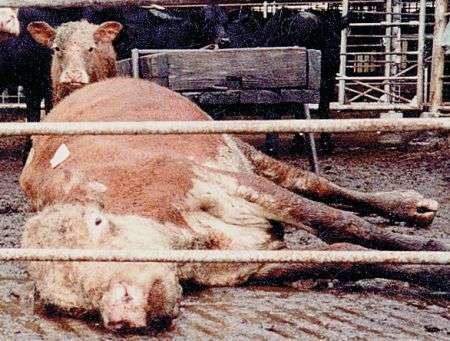Antibiotic Resistance
In agriculture, antibiotics are used for veterinary medicine, additives for food, and biocides
are used for veterinary medicine, additives for food, and biocides . Although antibiotics were originally used to treat livestock that have specific diseases, the vast majority of them are now used in industrial food animal production (IFAP) to prevent infections from various pathogens that infect the livestock due to their close living quarters, lack of clean living spaces, and weakened immune systems from lack of exercise and nutrition. This leads cattle to contract diseases The antibiotics also help animals grow larger to provide more meat. In low doses, antibiotics can help animals grow larger, but the biological mechanism for why this occurs is still unknown. These heavier animals produce a greater quantity of meat and thus generate higher profits.
. Although antibiotics were originally used to treat livestock that have specific diseases, the vast majority of them are now used in industrial food animal production (IFAP) to prevent infections from various pathogens that infect the livestock due to their close living quarters, lack of clean living spaces, and weakened immune systems from lack of exercise and nutrition. This leads cattle to contract diseases The antibiotics also help animals grow larger to provide more meat. In low doses, antibiotics can help animals grow larger, but the biological mechanism for why this occurs is still unknown. These heavier animals produce a greater quantity of meat and thus generate higher profits.
Overuse of Antibiotics
The use of antibiotics in factory farming is on a greater scale than any other use of antimicrobials around the world, and most major classes of antibiotics are being used this way. Approximately 80% of antibiotics consumed in the United States go to factory farms. Antibiotic resistance is growing rapidly and weakens the efficacy of medicine. Staphylococcus aureus (MRSA), H1N1 flu strains, and Plasmodium falciparum (malaria) have changed and are growing immune to more antibiotics at a rapid rate (Antimicrobial Resistance, CDC).
IFAP breeds dangerous pathogens due to the dense confinement of high quantities of animals and the distribution of CAFO. This wide-scale enclosure of zoonotic diseases, or zoonosis in small spaces increases the magnitude of disease transfer, especially because the confined livestock are repeatedly exposed to their own waste and that of the animals around them as shown in the image below.
in small spaces increases the magnitude of disease transfer, especially because the confined livestock are repeatedly exposed to their own waste and that of the animals around them as shown in the image below.

The excessive use of antibiotics is concerning because the antibiotics which animals receive are not regulated or recorded. When antibiotics are administered to large quantities of healthy animals, the bacteria is more likely to mutate and develop resistance simply because it is being distributed in large quantities. Antimicrobial-resistant bacterial infections spread many emerging infectious diseases, such as E. coli O157:H7. Random mutations in bacteria can change their genome, causing them to become resistant to antibiotics but still cause illness. For example, random mutations can create bacteria with altered cell walls that medicine can't bind to or enzymes that render antibiotics inactive. In the IFAP system, livestock routinely receive the same antibiotics that humans use as medication, so when humans consume meat with resistant bacteria and they colonize within the human body, the antibiotics people take against them fail to have an effect. As a result, many antibiotics are rapidly growing ineffective due to the expansion of factory farming.
The following video clip shows a news special demonstrating the creation of drug resistant bacteria due to over distribution of antibiotics in livestock.
Development of Resistance
Because farmers are giving healthy animals such high doses of antibiotics, antibiotic resistant bacteria develop in their intestines. Furthermore, antibiotic-resistant bacteria remain in the feces of animals and can contaminate crops when they are used as fertilizer. When produce and other farm products fall or aren't handled in a sanitary way, they can become contaminated with these bacteria particles as well. When not handled carefully or washed away thoroughly, these remain on food products and are consumed by humans, who become sick. The cycle can grow even more vicious when people take incorrectly diagnosed antibiotics with the belief that it will heal them faster, creating additional resistance in other bacteria.
Overuse of antibiotics in livestock has led the greater antibiotic resistance, leaving a lack of options for those in need of antibiotics for treatment. The photo album activity below illustrates some of the consequences of antibiotic resistance.
| Turn the pages by clicking on the right or left side of each page to learn more about the different EDS models. | ||
| Click below the question to view the answer. | ||

